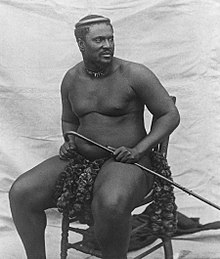Cetshwayo
Cetshwayo kaMpande (depending on the translation also Silkaat ) (* around 1826 near Eshowe , Kingdom of Zululand ; † February 8, 1884 there ), was the last sovereign king of the Zulu from 1872 to 1879 and their leader in the Zulu War .
Fratricidal war
Cetshwayo was born the son of the Zulu king Mpande , a half-brother of the king Shaka . Mpande died in 1873 and Cetshwayo became king on September 1st. In the run-up there had already been a long battle between Cetshwayo and his brother Mbuyazi for the succession to the throne. The battle culminated on December 2, 1856 in the Prince's Battle, in which Mbuyazi was killed. Cetshwayo created a new capital - Ulundi (high place) . He expanded his army and banished the Christian missionaries from his country.
Zulu War
On the northern border of the British colony of Natal , Zululand under Cetshwayo represented an important power factor in the region with its large and well-organized army in the early 1870s two Zulu warriors kidnapped two girls from Natal. However, Cetshwayo only sent £ 50 in gold. When two explorers were captured in Zululand, Frere asked for more compensation. Cetshwayo rejected these demands. On December 11, 1878, Frere gave the Zulu an ultimatum . In it were u. a. the cessation of raids on British settlers, undisturbed missionary work , a British envoy in Zululand and the reorganization of the Zulu army, whose deployment should also depend on British approval, called for.
After the ultimatum had expired, British colonial troops under Lieutenant General Lord Chelmsford invaded the Zulu Empire from Natal in January 1879 . On January 22nd, Cetshwayo's army was able to destroy part of the British armed forces in the battle of Isandhlwana .
Lord Chelmsford began restructuring his troops in the summer. The British sent troops from across the Empire to South Africa during this period. In the battle of Ulundi on July 4, 1879, the technically superior British were able to destroy the Zulu army.
The End

The Zulu king survived the battle and fled north while the remnants of his army scattered in all directions. Two weeks after the decisive battle, the British announced that the Zulu Kingdom no longer existed. Cetshwayo was captured a month later, on August 28th, and taken by ship to his prison exile in Cape Town . The Zululand was divided into thirteen separate kingdoms.
In 1882 there was a civil war between supporters and enemies of Cetshwayo . Because of this, the British allowed him to travel to London . His arrival there on August 5, 1882, and his audiences with Queen Victoria aroused tremendous public interest. Cetshwayo returned to Zululand in January 1883 after agreeing to keep the peace against his enemies.
After the death of Cetshwayo (1884), his son Dinuzulu ascended the throne. In contrast to his father, Dinuzulu was no longer a sovereign king and could only enforce his power with the help of the Boer state Transvaal .
literature
- Philip J. Haythornthwaite: The Colonial Wars Source Book . Arms and Armor, London 1997, ISBN 1-85409-436-X .
Individual evidence
| personal data | |
|---|---|
| SURNAME | Cetshwayo |
| ALTERNATIVE NAMES | Cetshwayo kaMpande (full name); Silkaat; Cettiwayo |
| BRIEF DESCRIPTION | last sovereign king of the Zulu (1872–1879) and their leader in the Zulu War |
| DATE OF BIRTH | around 1826 |
| PLACE OF BIRTH | near Eshowe |
| DATE OF DEATH | February 8, 1884 |
| Place of death | Eshowe |
